
Biggin Hill is a town in South East London, England, within the London Borough of Bromley. It is situated beyond London's contiguous built-up area in the Metropolitan green belt, 15.2 miles (24.5 km) south-southeast of Charing Cross. It is located adjacent to the Greater London boundary with Kent and Surrey. Prior to the creation of Greater London in 1965, it was in the historic and administrative county of Kent. At the 2011 Census, Biggin Hill had a population of 9,951.
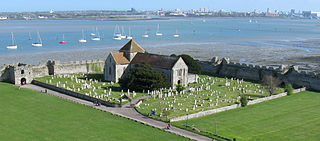
Portchester is a village in the borough of Fareham in Hampshire, England. It is 4 miles (6.4 km) northwest of Portsmouth and around 18 miles east of Southampton on the A27 road. Its population according to the 2011 United Kingdom census was 17,789.

Allington is an almost entirely modern village situated alongside the sides of the A20 road west of Maidstone in Kent, England. It is part of the built-up area of Maidstone.

Eynsford is a village and civil parish in the Sevenoaks District of Kent, England. It is located 3.3 miles (5 km) south east of Swanley, 7 miles (11 km) south of Dartford.

West Thurrock is an area, former civil parish and traditional Church of England parish in Thurrock, Essex, England, located 18 miles (28.1 km) east south-east of Charing Cross, London.

Barfrestone is a village and a former civil parish, now in the parish of Eythorne, in the Dover district, in east Kent, England. It is between Shepherdswell, Eythorne and Nonington, close to the former pit villages of Elvington and Snowdown. In 1931 the parish had a population of 91. On 1 April 1935 the parish was abolished and merged with Eythorne.
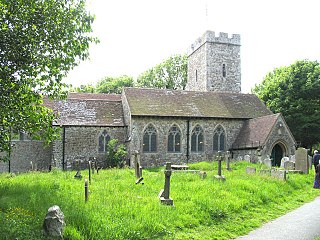
Cheriton is a northern suburb of Folkestone, in the Folkestone and Hythe, in the county of Kent, England. It is the location of the English terminal of the Channel Tunnel as well as of the major army barracks of Shorncliffe Camp.

Crofton Roman Villa in Crofton, Orpington, in the London Borough of Bromley, is a Roman villa which was inhabited between approximately 140 and 400 AD. It was the centre of a farming estate of about 500 acres (200 ha), with farm buildings nearby, surrounded by fields, meadows and woods. The house was altered several times during its 260 years of occupation, and at its largest it probably had at least 20 rooms.

Radipole is a suburb of Weymouth in Dorset, England.
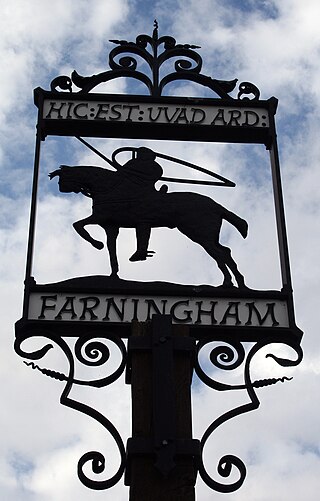
Farningham is a village and civil parish in the Sevenoaks District of Kent, England. It is located 3 miles (5 km) south-east of Swanley. It has a population of 1,314.
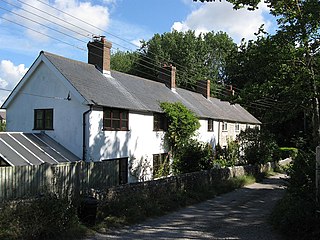
Bishopstone is a village and former civil parish, now in the parish of Seaford, in the Lewes district, in the county of East Sussex, England. Bishopstone Village has a population of about 200 people, including the nearby hamlet of Norton. It is located on a no-through country lane west of the town of Seaford, in the South Downs National Park.

Lullingstone Castle is a historic manor house, set in an estate in the village of Lullingstone and the civil parish of Eynsford in the English county of Kent. It has been inhabited by members of the Hart Dyke family for twenty generations including current owner Tom Hart Dyke.

Hooton is a suburban village and former civil parish on the Wirral Peninsula, within the unitary authority of Cheshire West and Chester and the ceremonial county of Cheshire, England. It was once a separate village but was incorporated into Ellesmere Port as the town expanded outwards during the twentieth century.

Crosby-on-Eden is the combined name for two small villages, High Crosby and Low Crosby, within the civil parish of Stanwix Rural near Carlisle, in the Cumberland district, in the ceremonial county of Cumbria, England. It was formerly a parish in its own right under the name Crosby upon Eden. In 1931 the parish had a population of 238. On 1 April 1934 the parish was abolished and merged with Stanwix Rural, part also went to Wetheral.

Gayton is a small rural village and civil parish in Staffordshire, located approximately 1 mile from the A51 between Stone and Stafford. In 2001 it had 167 residents, with 1 letter box, one bus stop, and new village hall. The post box is owned now by the village as is the telephone booth. The post code for Gayton properties normally start with ST18.
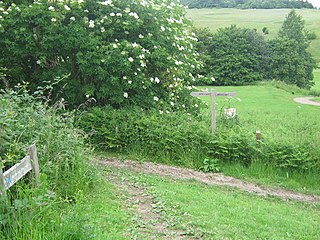
Lullingstone Country Park is near Eynsford, in Kent, England. A former deer park of a large estate, it was later sold to become an open-space and woodland park. The park and Lullingstone Castle are a Scheduled Monument, and an area of 66.4-hectare (164-acre) is a biological Site of Special Scientific Interest Kent.

Preston Hill Country Park is in Eynsford, in Kent, England. It is a woodland and former military firing range.

Lullingstone railway station is an unopened station on the Maidstone line which was constructed to serve a proposed airport and expected residential development at Lullingstone near Eynsford in Kent. The station was never brought into use as World War II and subsequent post-war planning legislation put an end to the plans for the area. Largely demolished in 1955, the remains of the station are visible to the south of the Eynsford Tunnel.
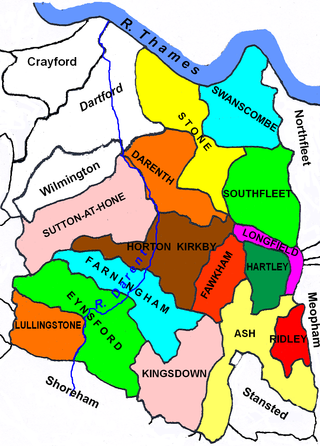
Axstane was a hundred in the county of Kent, England. The Hundred of Axstane lay south-east of Dartford and Wilmington Hundred. It is called Achestan in Domesday Book, but by the reign of Edward I it was called Axstane.

Lullingstone airfield was a proposed airfield in Kent, United Kingdom that was not constructed. Lullingstone railway station was constructed to serve the airport, but never opened to public services.





















